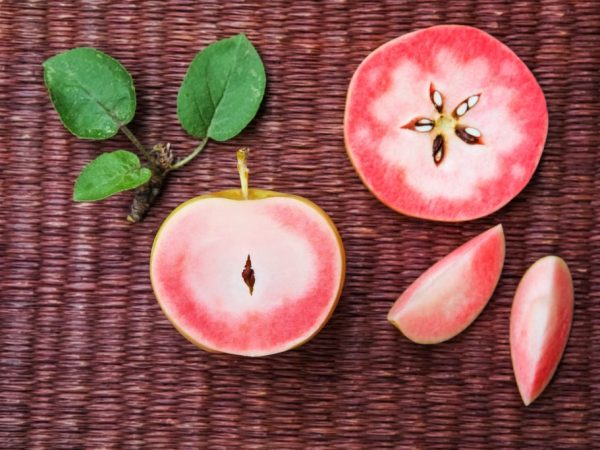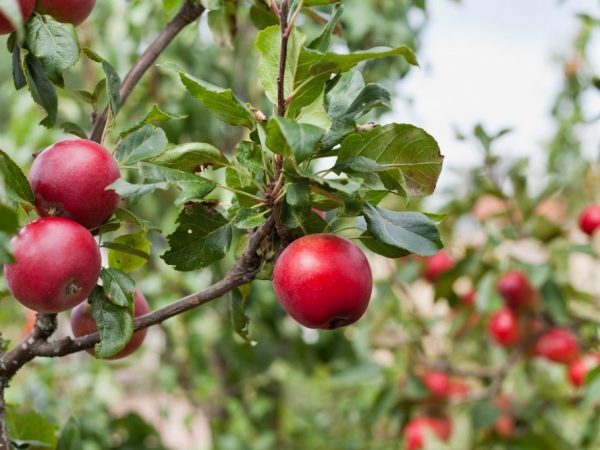Growing an apple tree Pink pearls
Apple tree Pink pearls are one of the best varieties of these fruit trees. It was bred in the United States more than 150 years ago. Having seen and tasted its fruits once, every gardener will want to decorate his plot with her. The combination of an unusual appearance, taste and unpretentiousness of the apple tree makes it a truly elite variety.

Growing an apple tree Pink pearls
Description
The fruits of this tree differ in the color of their pulp. It is bright red with a pearlescent tint. Such apples are sometimes called red meat.
The fruits are juicy and soft. They have a tart taste with grapefruit notes, and the aroma of raspberries organically completes this successful combination. The peel of apples is red, sometimes with a purple tint, covered with light small blotches. The fruits are low in calories.
The Pink Pearl apple variety is a winter variety. The tree is medium-sized. The shelf life of fruits is up to 4 months. Due to their specific spicy notes, apples are successfully used in cooking for savory dishes, and the seeds, if crushed, will complement the pepper seasoning.
Sapling selection
At home, in America, the variety is highly popular and is grown for sale. In Russia, he has not yet acquired such fame, therefore, in most cases, he is planted for himself or for the small sale of seedlings and the fruits themselves.
When buying, you should pay special attention to the tree. Without certain knowledge, you can purchase an apple tree that will not meet expectations in the future. Better to buy a one year old sapling. He must have a closed root system in a special container or with an earthen embankment.
If you have the opportunity to examine the roots when buying, pay attention to them. They should be densely developed, and their length should not be shorter than 25 cm.The optimal trunk thickness is 3 cm.
Landing

Fleshy apples
A tree is planted and looked after according to the classical method. This apple tree is thermophilic, it grows well in the southern part of the site, in a place protected from drafts. Particular attention should be paid to the location of groundwater.
If they are closer than 2 m to the root system, excessive moisture may threaten the tree. In this case, you need to plant it in a hilly area or prevent water from reaching the roots. The drainage and drainage method solves this problem well.
Timing
The best period for planting a pink pearl apple tree is spring. If planted in the fall, then strictly before the onset of frost. In the spring, you need to wait for the moment until the soil moves away from the cold and heats up.
Soil preparation
Having determined the size of the soil coma on the roots, you can understand what size the seedling hole will be. She should be twice his size. Such a pit should settle for at least a week before planting. Fertilizers must be added to the finished hole: manure or humus.
You can add peat. If the soil is acidic, then wood ash will help reduce this property, 250-300 g will be enough for one pit.When using manure, you should not take fresh manure, it can injure young roots, lime has the same effect.
Seedling preparation
The seedling should not be freed from the earth coma; together with it, it is placed in the planting pit. If the roots are open, on the contrary, they need to be fluffed up so that they adapt well to the new soil.
Landing technology
When the pit and fertilizer mixture are ready, a third of the planting space is filled with the latter. A stake is driven into the bottom, which will serve as a support for the garter of the seedling. A young tree is located in the center of the pit, which is gradually filled with earth and consistently compacted.
The neck should rise 7 cm above the ground. Be sure to create earthen ridges around the planting space. You can mulch the soil by adding tyrsu or sawdust. Be sure to water the area around the seedling with 3 buckets of water.
Care
A prerequisite for care, as for any other variety of apples, is the timely watering of the tree, especially after planting. The harvest will be rich if the grower feeds the tree.
Be sure to add mulch, manure, humus, hay or sawdust. If you cut the tree in time, it will not only have a well-groomed appearance, but also get rid of dry and diseased branches.

Apple trees do not require much moisture
Watering
For good growth of the Pink Pearl apple tree, no special watering conditions are needed. It is enough to water it in hot periods several times a month with 1-2 buckets of water. If the gardener conducts a series of manipulations to retain moisture, such as mulching and fertilization, the tree will have enough natural rainfall.
Top dressing
The first year after planting is skipped - there is no need for fertilization. Everything that the tree needed for the first time, the gardener has already laid in the soil. Further feeding is done 2 times a year: in autumn and spring.
It is important to note that in autumn the tree's immunity is formed and its frost resistance increases. Special attention should be paid to fertilization during this period. It is best to carry out these activities after the harvest has been harvested.
An ideal mixture would be potassium sulfate and superphosphate in proportions 1: 1, you should take 300 g of each substance.
Spring feeding takes place mainly in April. It is necessary to fluff the ground and add any fertilizer with nitrogen in the composition. It can be both natural products (dung, mullein) and mineral products (urea).
To do this, you need to mentally outline the crown on the ground and in this place dig small pits up to 40 cm deep.When the tree begins to bloom, the above dressings should be added to these pits.
Pruning and shaping the crown
The Pink Pearl apple tree, being a semi-dwarf tree, does not grow higher than 4 m.
Pruning is carried out for the following purposes:
- as a sanitary measure;
- for a rejuvenating effect;
- to increase the number of new branches;
- to stimulate growth.
The first pruning is done after planting, in the spring before budding. The branches near the trunk should be shortened by a third. This procedure needs to be carried out every year.
The crown is pruned to 6 years. During this period, the tree stimulates its growth, then it slows down, and the created shape is preserved.
After this procedure, the sections are coated with garden varnish.
Preparing for winter
The trees tolerate winter and frosts perfectly. Fertilizers applied in autumn are enough for the tree to successfully endure the cold season. Gardeners put mulch on the snow when the air temperature rises: together with melt water, nutrients are better absorbed.
These measures are not necessary, you can apply them at your discretion.
Hares can become a much bigger problem than cold weather if they live near a garden or plot. They can encroach on the young bark that appears on the tree and thereby significantly damage the trunk structure.
To avoid such problems, trees should be wrapped according to the principle of trapping belts.You do not need to use an adhesive base; you should make a choice in favor of durable materials through which hares cannot get to the bark.
Protection against diseases and pests
The most unpleasant parasites of any garden are fungi: scab and powdery mildew take precedence. They penetrate the inside of the tree, eating it from the inside, forming cracks, rotting and leading to loss of crops.
The spread of the fungus is a consequence of the presence of excess moisture. It is necessary to carefully study the land and the location of groundwater, and if the moment is missed, the disease should be diagnosed in time. It can be easily identified by the characteristic light spots on the leaves, which darken over time.
Dampness causes fruit rot. It can be easily found on apples, it completely infects the entire tree and often leads to loss of yield.
If the gardener notices the appearance of these ailments in time and prevents them, there will be no problems with pests and diseases. It is enough to use 10% ammonium nitrate after flowering, and with the onset of winter, spray it with 7% urea.
Gardeners reviews
Every gardener who has ever come across this variety was delighted with it. He is absolutely unpretentious in care. Gives a gorgeous harvest and pleases with its delicious fruits.
In the south, the tree grows and thrives. Given its high frost resistance, the Pink Pearl apple tree is also grown in the Urals, in the North and West of Russia.
Apples are distinguished not only by their unusual appearance, but also by their rich palette of taste. The beneficial properties of the fruit are also noted. This is an elite variety that has absorbed excellent taste, beauty and unpretentious care.

